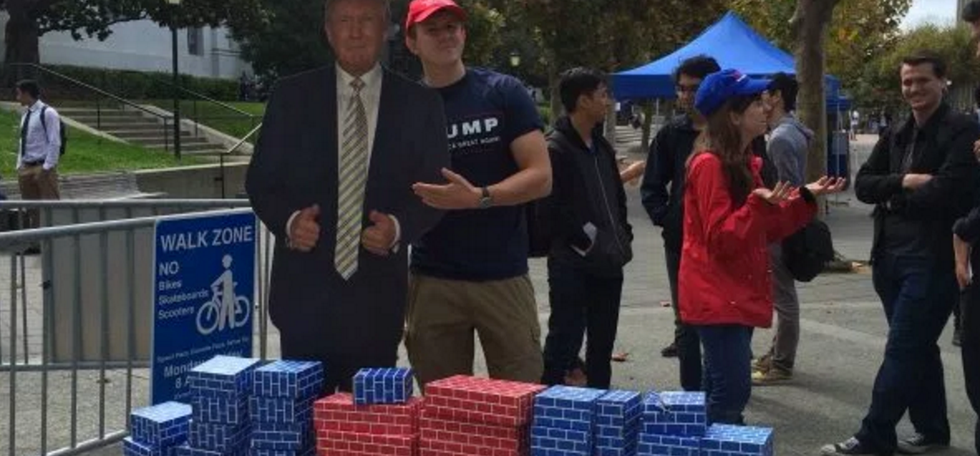As greens turn to rusty yellows and reds, Berkeley students flock back to campus for another year of alternative bouts of academia and alcohol, and clubs spring up on Sproul Plaza to recruit the best, brightest, and most passionate among them. They beam at prospective members and thrust thin fliers onto their prodigies, and in response, those students arm themselves with stoic faces, fast strides, and dark glasses to avoid giving the recruiters any hint of interest that might lead to them being further harassed. Chatter from the active members and muffled music from the earphones of the rest fill the open clearing, creating a harmonious melody that’s accompanied by a graceful dance: a choreography of mastered thrustings and side-steppings.
This past month, however, something disrupted the usual fall promenade. The Berkeley College Republicans, a group of students supporting the Republican party, and unfortunately, Trump, were met with a considerable amount of hostility. Glares and insults were shot at the group, and by the end of the week, the cardboard cutout of their presidential candidate of choice went from looking like this:
To this:
The tension escalated when an “undercover reporter” infiltrated the association and posed as a member. The reporter built a wall with miniature cardboard bricks, and convinced other members to join him.
As would be expected at what has been historically one of the country’s most progressive campuses, these actions were not well received. A confrontation occurred in which undocumented and/or anti-Trump students loudly expressed their distaste in vulgarities and chants. They attributed their actions to the feeling of insecurity and inferiority that the Republican party has generally created for them as targeted minorities. The Berkeley College Republicans also expressed feelings of distress. They felt as if they were being ostracized and persecuted because of who they were, a minority on campus, and their beliefs.
This incident has lead to the posing of an interesting question, however, one with there possibility of positive productiveness (excuse the alliteration): “Is free speech truly free?”
There are several ways to interpret and experience this question. What appears to be a multifaceted and complex problem boils down to two factors I commonly frequent in my articles: ignorance and fear.
In a recent meeting I attended of Latinos on campus, it seemed that the general consensus was that free speech loses that privilege when it becomes hate speech. Hate speech, in my opinion, occurs in two main forms: the first is blunt and unapologetic (see @DonaldTrump on Twitter). Its messages of inequality are geared in such a way that they allow for personal gain through a promotion hate with little to no basis in facts. When speech is used in this way, I think the speaker has to be prepared for, and open to, strong social critique. As the phrase in Spanish goes, el que se lleva se aguanta. By associating themselves with Trump’s hate speech, Republican supporters should acknowledge that this instigating hate speech that they are encouraging can be reciprocated (the morally high ground is a two way route, after all).
The second identifiable form in which hate speech is spread is through microagressions. Microagressions, specially racial ones, are most often fueled by unintentional ignorance. These cultural insensitivities include asking an Asian student for help on homework, for example, or dressing up in a sombrero and mustache for Halloween. They’re stereotypes, basically, and in many campuses across the nation, students are being taught to completely avoid them altogether. Here’s where I dissent from the popular opinion. There is a fine line between a microagression and an instigative, intentional hate message, and that should be acknowledged. The former is an opportunity still.
I was racially micro-aggressive just last week, when I asked my Indian suite mates if they had any sort of arranged marriages within their more Westernized social circles. I am well aware that it was an ignorant question, but I deemed it a necessary one in order for me to not only satisfy that curiosity but also understand the westernized Indian culture better. If these questions aren’t being asked, then the fear of ignorance will further propel actual ignorance.
If I tell someone they can't wear sombreros, I'm negating them and myself of an opportunity to learn about the Mexican culture (granted I take that chance to tell them about it). If I can't share my culture, and if I can't allow others to participate in it, I am conforming to the belief that being a minority means being a inferiority. And so, I reiterate: to improve is to know and to know is to engage in dialogue.
My takeaway from the Republican table debacle is that we can’t be overly sensitive towards words. We have to learn to question, (accept) critique, and have an open and free conversation about our views- as different as they may be. In this way, ignorance can be replaced by informed understandings, and hate speech can be replaced by productive, free speech.






 StableDiffusion
StableDiffusion StableDiffusion
StableDiffusion StableDiffusion
StableDiffusion Photo by
Photo by  Photo by
Photo by  Photo by
Photo by 
 Photo by
Photo by  Photo by
Photo by  Photo by
Photo by  Photo by
Photo by  Photo by
Photo by 












